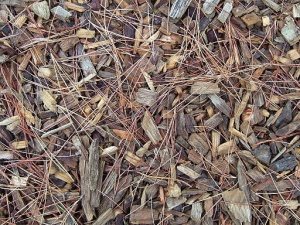Difference between revisions of "Mulch"
Jump to navigation
Jump to search
Jenny Hill (talk | contribs) |
Dean Young (talk | contribs) |
||
| (16 intermediate revisions by 4 users not shown) | |||
| Line 1: | Line 1: | ||
[[File:Wood chip mulch.jpg|thumb|Pine mulch will help hold moisture in the soil]] | |||
*Mulch is considered to be an normal finishing touch to many types of formal landscaping. Maintaining mulch application can help increase aesthetic value of LID BMPs. | |||
*As in other landscaping applications, the mulch helps to preserve soil moisture for plant survival, and suppresses weed growth. | |||
*Mulch can also help to maintain the organic matter content of underlying filter media, which provides cation exchange capacity for pollutant removal. | |||
*Regular fresh applications of wood mulch can also promote denitrification, reducing nitrates in impacted surface waters. | |||
<ref> Simcock, R and Dando, J. 2013. Mulch specification for stormwater bioretention devices. Prepared | *Mulch should be applied on the surface of the BMP in a layer of 75 -100 mm. | ||
by Landcare Research New Zealand Ltd for Auckland Council. Auckland Council technical report, TR2013/056 </ref | *Double-shredded hardwood or softwood mulch is recommended for LID facilities. Its fibrous texture knits together somewhat; providing limited erosion control. | ||
*In areas with particularly high flow (e.g. around [[inlets]] and [[forebays]]) coarse decorative aggregate or [[stone]] is recommended to better dissipate energy and protect it from erosion. | |||
*This advice also holds for [[stormwater planters]], which often experience concentrated flow from a [[downspout disconnection| roof downspout or drain]]. | |||
*All organic mulches have the potential to float and migrate in surface flow, particularly after a previously dry period. <ref> Simcock, R and Dando, J. 2013. Mulch specification for stormwater bioretention devices. Prepared by Landcare Research New Zealand Ltd for Auckland Council. Auckland Council technical report, TR2013/056 </ref> | |||
---- | ---- | ||
[[Category:Materials]] | [[Category:Materials]] | ||
[[Category:Green infrastructure]] | |||
Latest revision as of 15:01, 15 July 2020
- Mulch is considered to be an normal finishing touch to many types of formal landscaping. Maintaining mulch application can help increase aesthetic value of LID BMPs.
- As in other landscaping applications, the mulch helps to preserve soil moisture for plant survival, and suppresses weed growth.
- Mulch can also help to maintain the organic matter content of underlying filter media, which provides cation exchange capacity for pollutant removal.
- Regular fresh applications of wood mulch can also promote denitrification, reducing nitrates in impacted surface waters.
- Mulch should be applied on the surface of the BMP in a layer of 75 -100 mm.
- Double-shredded hardwood or softwood mulch is recommended for LID facilities. Its fibrous texture knits together somewhat; providing limited erosion control.
- In areas with particularly high flow (e.g. around inlets and forebays) coarse decorative aggregate or stone is recommended to better dissipate energy and protect it from erosion.
- This advice also holds for stormwater planters, which often experience concentrated flow from a roof downspout or drain.
- All organic mulches have the potential to float and migrate in surface flow, particularly after a previously dry period. [1]
- ↑ Simcock, R and Dando, J. 2013. Mulch specification for stormwater bioretention devices. Prepared by Landcare Research New Zealand Ltd for Auckland Council. Auckland Council technical report, TR2013/056
